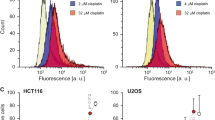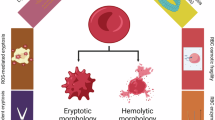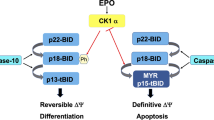Abstract
Although proteases of the caspase family are essential mediators of apoptosis in nucleated cells, in anucleate cells their presence and potential functions are almost completely unknown. Human erythrocytes are a major cell population that does not contain a cell nucleus or other organelles. However, during senescence they undergo certain morphological alterations resembling apoptosis. In the present study, we found that mature erythrocytes contain considerable amounts of caspase-3 and -8, whereas essential components of the mitochondrial apoptotic cascade such as caspase-9, Apaf-1 and cytochrome c were missing. Strikingly, although caspases of erythrocytes were functionally active in vitro, they failed to become activated in intact erythrocytes either during prolonged storage or in response to various proapoptotic stimuli. Following an increase of cytosolic calcium, instead the cysteine protease calpain but not caspases became activated and mediated fodrin cleavage and other morphological alterations such as cell shrinkage. Our results therefore suggest that erythrocytes do not have a functional death system. In addition, because of the presence of procaspases and the absence of a cell nucleus and mitochondria erythrocytes may be an attractive system to dissect the role of certain apoptosis-regulatory pathways. Cell Death and Differentiation (2001) 8, 1197–1206
Similar content being viewed by others
Log in or create a free account to read this content
Gain free access to this article, as well as selected content from this journal and more on nature.com
or
Abbreviations
- Ac-DEVD-AMC:
-
N-acetyl-Asp-Glu-Val-Asp-aminomethylcoumarin
- Apaf-1:
-
apoptotic protease-activating factor-1
- CD95L:
-
CD95 ligand
- CHX:
-
cycloheximide
- RBC:
-
red blood cell
- TNF:
-
tumor necrosis factor
- z-VAD-fmk:
-
benzyloxycarbonyl-Val-Ala-Asp-fluoromethyl ketone
References
Arends MJ, Morris RG, Wyllie AH . 1990 Apoptosis. The role of the endonuclease Am. J. Pathol. 136: 593–608
Rathmell JC, Thompson CB . 1999 The central effectors of cell death in the immune system Annu. Rev. Immunol. 17: 781–828
Cohen GM . 1997 Caspases: the executioners of apoptosis Biochem. J. 326: 1–16
Los M, Wesselborg S, Schulze-Osthoff K . 1999 The role of caspases in development, immunity, and apoptotic signal transduction: lessons from knockout mice Immunity 10: 629–639
Stroh C, Schulze-Osthoff K . 1998 Death by a thousand cuts: an ever increasing list of caspase substrates Cell Death Differ. 5: 997–1000
Muzio M, Chinnaiyan AM, Kishkel FC, O'Rourke K, Shevchenko A, Ni J, Scaffidi C, Bretz JD, Zhang M, Gentz R, Mann M, Krammer PH, Peter ME, Dixit VM . 1996 FLICE, a novel FADD-homologous ICE/CED-3-like protease, is recruited to the CD95 (Fas/APO-1) death-inducing signaling complex Cell 85: 817–827
Boldin MP, Goncharov TM, Goltsev YV, Wallach D . 1996 Involvement of MACH, a novel MORT1/FADD-interacting protease, in Fas/APO-1- and TNF receptor-induced cell death Cell 85: 803–815
Yang J, Liu X, Bhalla K, Kim CN, Ibrado AM, Cai J, Peng TI, Jones DP, Wang X . 1997 Prevention of apoptosis by Bcl-2: release of cytochrome c from mitochondria blocked Science 275: 1129–1132
Kluck RM, Bossy-Wetzel E, Green DR, Newmeyer DD . 1997 The release of cytochrome c from mitochondria: a primary site for Bcl-2 regulation of apoptosis Science 275: 1132–1136
Zou H, Henzel WJ, Liu X, Lutschg A, Wang X . 1997 Apaf-1, a human protein, homologous to C. elegans Ced-4, participates in cytochrome c-dependent activation of caspase-3 Cell 90: 405–413
Li P, Nijhawan D, Budihardjo I, Srinivasula SM, Ahmad M, Alnemri ES, Wang X . 1997 Cytochrome c and dATP-dependent formation of Apaf-1/Caspase-9 complex initiates an apoptotic protease cascade Cell 91: 479–489
Srinivasula SM, Ahmad M, Fernandes-Alnemri T, Alnemri ES . 1998 Autoactivation of procaspase-9 by Apaf-1-mediated oligomerization Mol. Cell. 1: 949–957
Sorimachi H, Ishiura S, Suzuki K . 1997 Structure and physiological function of calpains Biochem. J. 328: 721–732
Carafoli E, Molinari M . 1998 Calpain: a protease in search of a function? Biochem. Biophys. Res. Commun. 247: 193–203
Chan SL, Mattson MP . 1999 Caspase and calpain substrates: roles in synaptic plasticity and cell death J. Neurosci. Res. 58: 167–190
Wang KKW . 2000 Calpain and caspase: can you tell the difference? Trends Neurosci. 23: 20–26
Waterhouse NJ, Finucane DM, Green DR, Elce JS, Kumar S, Alnemri ES, Litwack G, Khanna K, Lavin MF, Watters DJ . 1998 Calpain activation is upstream of caspases in radiation-induced apoptosis Cell Death Differ. 5: 1051–1061
Ruiz-Vela A, Gonzalez de Buitrago G, Martinez AC . 1999 Implication of calpain in caspase activation during B cell clonal deletion EMBO J. 18: 4988–4998
Wood DE, Newcomb EW . 1999 Caspase-dependent activation of calpain during drug-induced apoptosis J. Biol. Chem. 274: 8309–8315
Wolf BB, Goldstein JC, Stennicke HR, Beere H, Amarante-Mendes GP, Salvesen GS, Green DR . 1999 Calpain functions in a caspase-independent manner to promote apoptosis-like events during platelet activation Blood 94: 1683–1692
Chua BT, Guo K, Li P . 2000 Direct cleavage by the calcium-activated protease calpain can lead to inactivation of caspases J. Biol. Chem. 275: 5131–5135
Lankiewicz S, Luetjens MC, Bui NT, Krohn AJ, Poppe M, Cole GM, Saido TC, Prehn JH . 2000 Activation of calpain I converts excitotoxic neuron death into a caspase-independent cell death J. Biol. Chem. 275: 17064–17071
Waugh RE, Narla M, Jackson CW, Mueller TJ, Suzuki T, Dale GL . 1992 Rheologic properties of senescent erythrocytes: loss of surface area and volume with red blood cell age Blood 79: 1351–1358
Mohandas N, Groner W . 1989 Cell membrane and volume changes during red cell development and aging Ann. N. Y. Acad. Sci. 554: 217–224
Connor J, Pak CC, Schroit AJ . 1994 Exposure of phosphatidylserine in the outer leaflet of human red blood cells. Relationship to cell density, cell age, and clearance by mononuclear cells J. Biol. Chem. 269: 2399–2404
Bratosin D, Mazurier J, Tissier JP, Estaquier J, Huart JJ, Ameisen JC, Aminoff D, Montreuil J . 1998 Cellular and molecular mechanisms of senescent erythrocyte phagocytosis by macrophages Biochimie 80: 173–195
Boas FE, Forman L, Beutler E . 1998 Phosphatidylserine exposure and red cell viability in red cell aging and in hemolytic anemia Proc. Natl. Acad. Sci. USA 95: 3077–3081
Silva M, Grillot D, Benito A, Richard C, Nunez G, Fernandez-Luna JL . 1996 Erythropoietin can promote erythroid progenitor survival by repressing apoptosis through Bcl-XL and Bcl-2 Blood 88: 1576–1582
Gregori PA, Bondurant MC . 1997 The roles of Bcl-X(L) and apopain in the control of erythropoiesis by erythropoietin Blood 90: 630–640
Gregoli PA, Bondurant MC . 1999 Function of caspases in regulating apoptosis caused by erythropoietin deprivation in erythroid progenitors J. Cell Physiol. 178: 133–143
Motoyama N, Kimura T, Takahashi T, Watanabe T, Nakano T . 1999 Bcl-x prevents apoptotic cell death of both primitive and definitive erythrocytes at the end of maturation J. Exp. Med. 189: 1691–1698
De Maria R, Testa U, Luchetti L, Zeuner A, Stassi G, Pelosi E, Riccioni R, Felli N, Samoggia P, Peschle C . 1999 Apoptotic role of Fas/Fas ligand system in the regulation of erythropoiesis Blood 93: 796–803
Zamai L, Secchiero P, Pierpaoli S, Bassini A, Papa S, Alnemri ES, Guidotti L, Vitale M, Zauli G . 2000 TNF-related apoptosis-inducing ligand (TRAIL) as a negative regulator of normal human erythropoiesis Blood 95: 3716–3724
Wesselborg S, Engels IH, Rossmann E, Los M, Schulze-Osthoff K . 1999 Anticancer drugs induce caspase-8/FLICE activation and apoptosis in the absence of CD95 receptor/ligand interaction Blood 93: 3053–3063
Herr I, Wilhelm D, Bohler T, Angel P, Debatin KM . 1997 Activation of CD95 (APO-1/Fas) signaling by ceramide mediates cancer therapy-induced apoptosis EMBO J. 16: 6200–6208
Goldkorn T, Balaban N, Shannon M, Chea V, Matsukuma K, Gilchrist D, Wang H, Chan C . 1998 H2O2 acts on cellular membranes to generate ceramide signaling and initiate apoptosis in tracheobronchial epithelial cells J. Cell Sci. 111: 3209–3220
Ojcius DM, Zychlinsky A, Zheng LM, Young JD . 1991 Ionophore-induced apoptosis: role of DNA fragmentation and calcium fluxes Exp. Cell Res. 197: 43–49
Consoli U, El-Tounsi I, Sandoval A, Snell V, Kleine HD, Brown W, Robinson JR, DiRaimondo F, Plunkett W, Andreeff M . 1998 Differential induction of apoptosis by fludarabine monophosphate in leukemic B and normal T cells in chronic lymphocytic leukemia Blood 91: 1742–1748
Bertrand R, Solary E, O'Connor P, Kohn KW, Pommier Y . 1994 Induction of a common pathway of apoptosis by staurosporine Exp. Cell Res. 211: 314–321
Slee EA, Harte MT, Kluck RM, Wolf BB, Casiano CA, Newmeyer DD, Wang HG, Reed JC, Nicholson DW, Alnemri ES, Green DR, Martin SJ . 1999 Ordering the cytochrome c-initiated caspase cascade: hierarchical activation of caspases-2, -3, -6, -7, -8, and -10 in a caspase-9-dependent manner J. Cell Biol. 144: 281–292
Van de Craen M, Declercq W, Van den Brande I, Fiers W, Vandenabeele P . 1999 The proteolytic procaspase activation network: an in vitro analysis Cell Death Differ. 6: 1117–1124
Jänicke RU, Ng P, Sprengart ML, Porter AG . 1998 Caspase-3 is required for alpha-fodrin cleavage but dispensable for cleavage of other death substrates in apoptosis J. Biol. Chem. 273: 15540–15545
Takadera T, Ohyashiki T . 1997 Apoptotic cell death and caspase 3 (CPP32) activation induced by calcium ionophore at low concentrations and their prevention by nerve growth factor in PC12 cells Eur. J. Biochem. 249: 8–12
Nakamura K, Bossy-Wetzel E, Burns K, Fadel MP, Lozyk M, Goping IS, Opas M, Bleackley RC, Green DR, Michalak M . 2000 Changes in endoplasmic reticulum luminal environment affect cell sensitivity to apoptosis J. Cell Biol. 150: 731–740
Shiga T, Sekiya M, Maeda N, Kon K, Okazaki M . 1985 Cell age-dependent changes in deformability and calcium accumulation of human erythrocytes Biochim. Biophys. Acta 814: 289–299
Romero PJ, Romero EA . 1999 Effect of cell ageing on Ca2+ influx into human red cells Cell Calcium 26: 131–137
Allan D, Thomas P . 1981 Ca2+-induced biochemical changes in human erythrocytes and their relation to microvesiculation Biochem. J. 198: 433–440
Allan D, Thomas P . 1981 The effects of Ca2+ and Sr2+ on Ca2+-sensitive biochemical changes in human erythrocytes and their membranes Biochem. J. 198: 441–445
Henseleit U, Plasa G, Haest C . 1990 Effects of divalent cations on lipid flip-flop in the human erythrocyte membrane Biochim. Biophys. Acta 1029: 127–135
Weil M, Jacobson MD, Raff MC . 1998 Are caspases involved in the death of cells with a transcriptionally inactive nucleus? Sperm and chicken erythrocytes J. Cell Sci. 111: 2707–2715
Danon D, Marikovsky Y . 1988 The aging of the red blood cell. A multifactor process Blood Cells 14: 7–18
Dolis D, Moreau C, Zachowski A, Devaux PF . 1997 Aminophospholipid translocase and proteins involved in transmembrane phospholipid traffic Biophys. Chem. 68: 221–231
Haest CW, Plasa G, Kamp D, Deuticke B . 1978 Spectrin as a stabilizer of the phospholipid asymmetry in the human erythrocyte membrane Biochim. Biophys. Acta 509: 21–32
Bronk SF, Gores GJ . 1993 pH-dependent nonlysosomal proteolysis contributes to lethal anoxic injury of rat hepatocytes Am. J. Physiol. 264: G744–751
Squier MK, Miller AC, Malkinson AM, Cohen JJ . 1994 Calpain activation in apoptosis J. Cell Physiol. 159: 229–237
Glaser T, Schwarz-Benmeir N, Barnoy S, Barak S, Eshhar Z, Kosower NS . 1994 Calpain (Ca(2+)-dependent thiol protease) in erythrocytes of young and old individuals Proc. Natl. Acad. Sci. USA 91: 7879–7883
Salamino F, Sparatore B, De Tullio R . 1991 The calpastatin defect in hypertension is possibly due to a specific degradation by calpain Biochim. Biophys. Acta 1096: 265–269
Porn-Ares MI, Samali A, Orrenius S . 1998 Cleavage of the calpain inhibitor, calpastatin, during apoptosis Cell Death Differ. 5: 1028–1033
Squier MK, Sehnert AJ, Sellins KS, Malkinson AM, Takano E, Cohen JJ . 1999 Calpain and calpastatin regulate neutrophil apoptosis J. Cell Physiol. 178: 311–319
Zermati Y, Garrido C, Amsellem S, Fishelson S, Bouscary D, Valensi F, Varet B, Solary E, Hermine O . 2001 Caspase activation is required for terminal erythroid differentiation J. Exp. Med. 193: 247–254
Acknowledgements
The authors wish to thank Dr. V Dixit for kindly providing the bacterial expression plasmid for caspase-6. This work was supported in part by grants from the Federal Ministry of Education, Science, Research and Technology (Fö. 01KS9602) and the Interdisciplinary Center of Clinical Research (IZKF) of the Universities of Tübingen and Münster. S Wesselborg acknowledges a fellowship from the Federal Ministry of Education, Science, Research and Technology, and C Berg from the Fortune Program of the University of Tübingen.
Author information
Authors and Affiliations
Corresponding author
Additional information
Edited by S Martin
Rights and permissions
About this article
Cite this article
Berg, C., Engels, I., Rothbart, A. et al. Human mature red blood cells express caspase-3 and caspase-8, but are devoid of mitochondrial regulators of apoptosis. Cell Death Differ 8, 1197–1206 (2001). https://doi.org/10.1038/sj.cdd.4400905
Received:
Revised:
Accepted:
Published:
Issue date:
DOI: https://doi.org/10.1038/sj.cdd.4400905
Keywords
This article is cited by
-
High-throughput, label-free, single-cell photoacoustic microscopy of intratumoral metabolic heterogeneity
Nature Biomedical Engineering (2019)
-
Eryptosis of non-parasitized erythrocytes is related to anemia in Plasmodium berghei low parasitema malaria of Wistar rats
Parasitology Research (2019)
-
Caspase-3 and caspase-8 expression in breast cancer: caspase-3 is associated with survival
Apoptosis (2017)
-
Cytotoxic and apoptotic activities of extract of Amaranthus spinosus L. in Allium cepa and human erythrocytes
Cytotechnology (2017)
-
Purified Lesser weever fish venom (Trachinus vipera) induces eryptosis, apoptosis and cell cycle arrest
Scientific Reports (2016)



